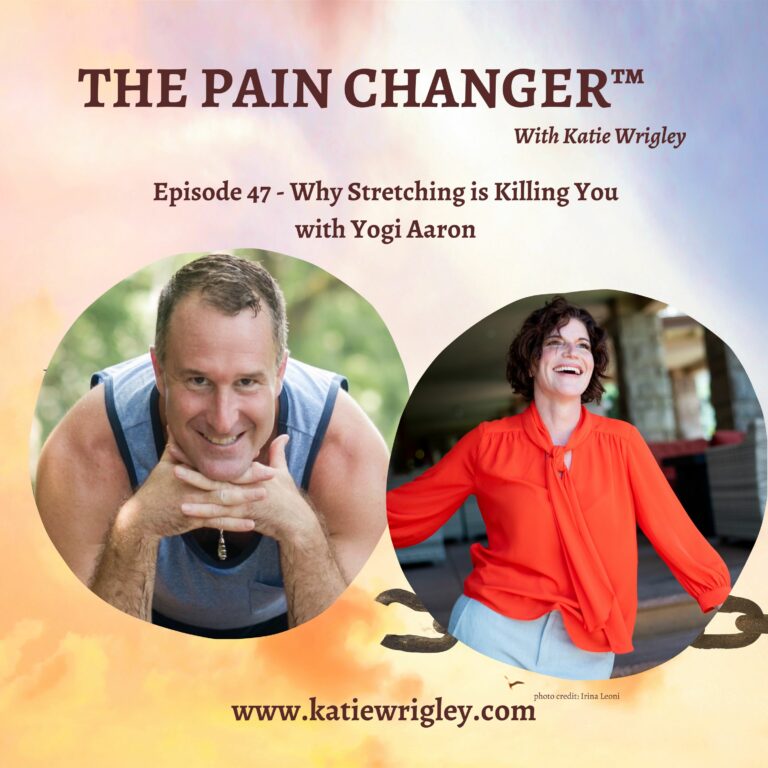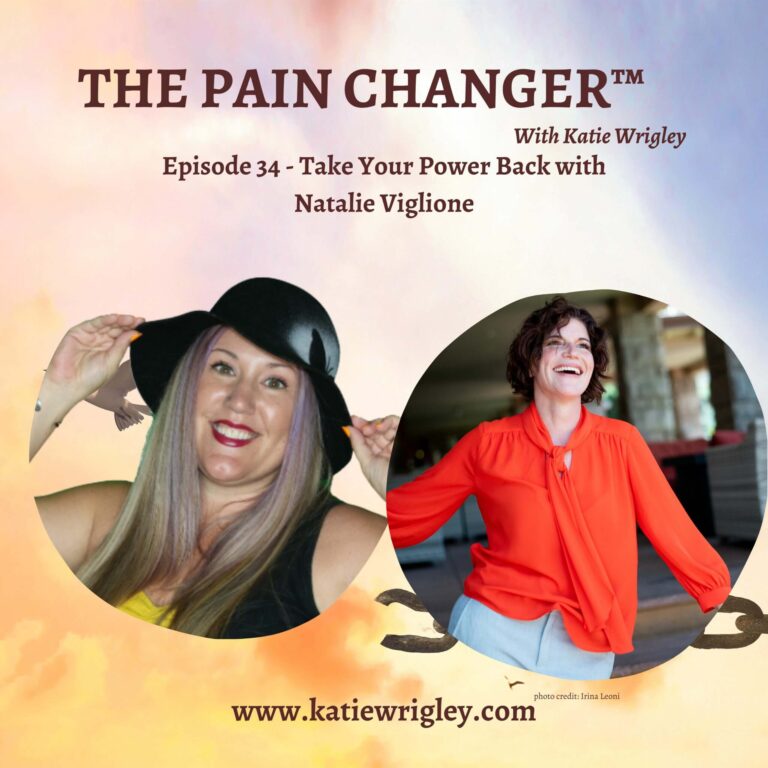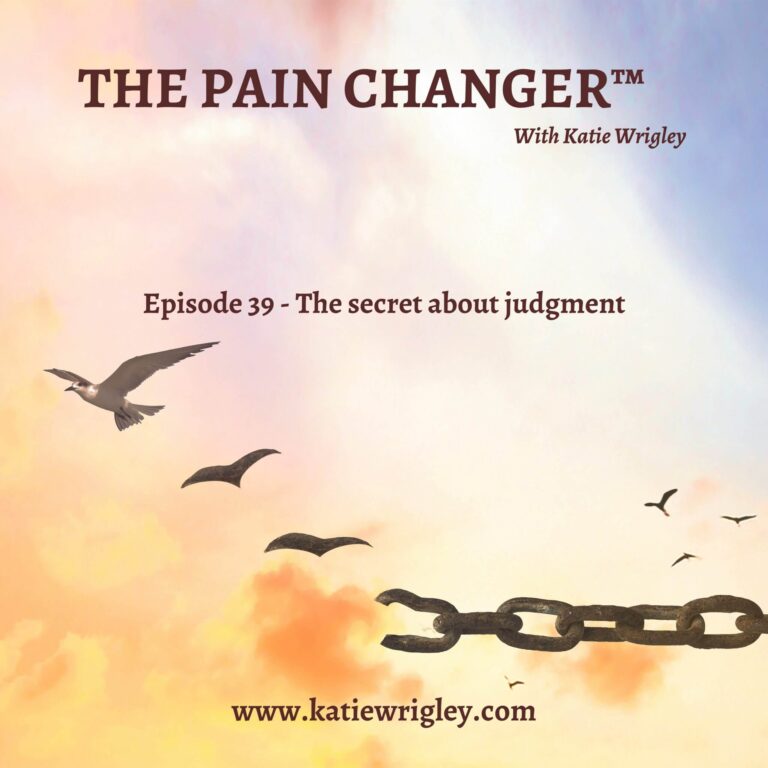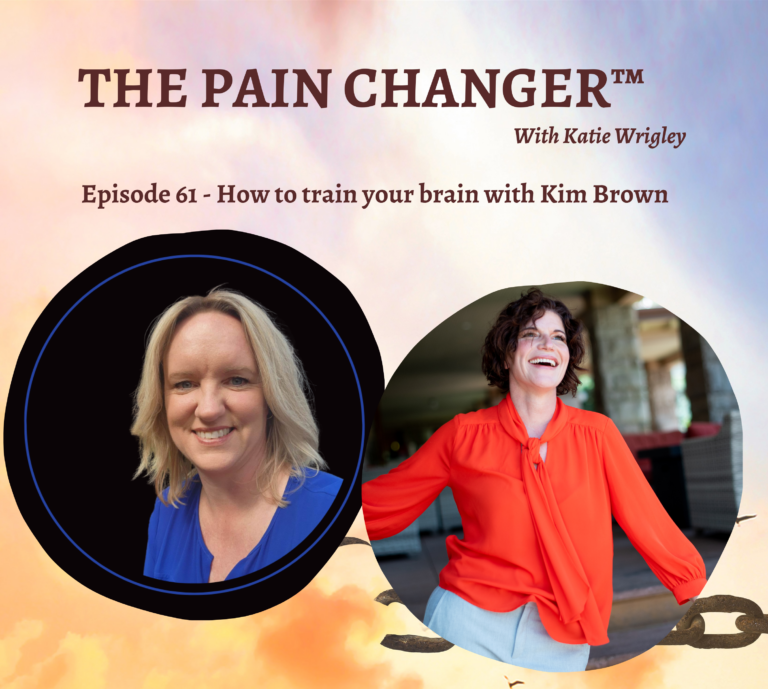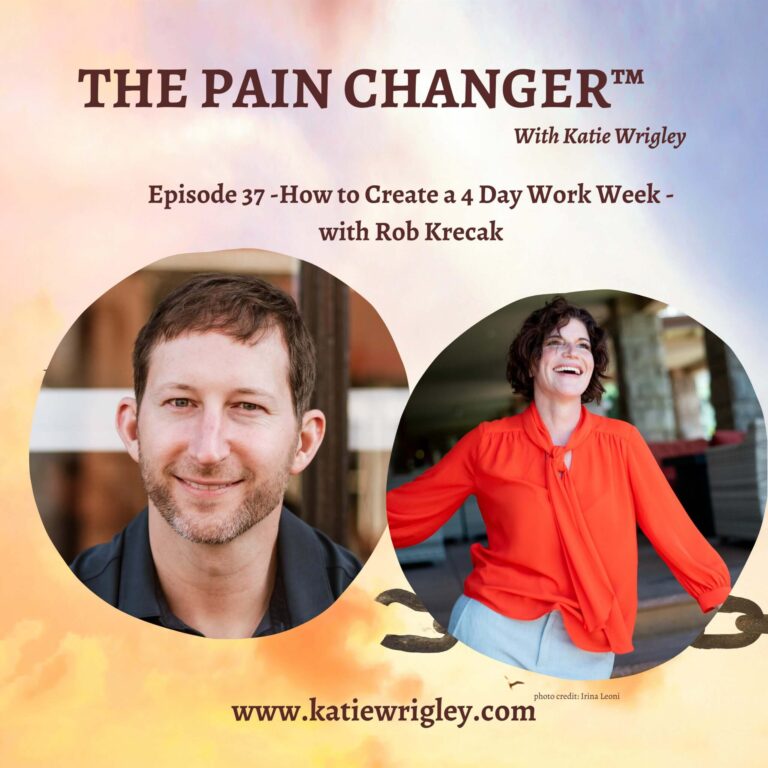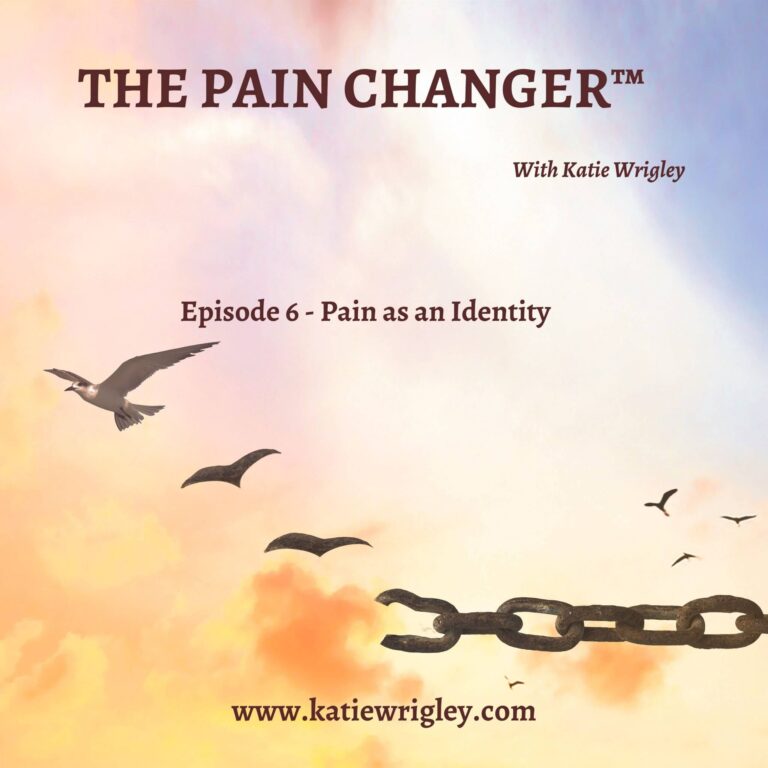Episode 2: WTF is Cognomovement??
Transcript…
Learn what Cognomovement is and how it can help relieve symptoms of chronic conditions. Experience a small sample during the episode!
If you have followed Katie at all, or even if you’ve only heard the episode on her story with pain, you may be wondering what cognitive movement is. Before we dive in though, go grab something that’s safe to consume, such as a snack, drink, supplement or medication. You’ll see why shortly.
Today, you’re going to learn what cognitive movement today, you’re going to learn what cognitive movement is and how it can help influence chronic pain.
Welcome to the pain changer podcast where you learn insider tips and tricks to help you improve your pain levels. Without the nearly daily trips to the doctor or heavy pain meds. When you change your mind. You will change your experience with pain. Every week, the pain change your podcast will teach you new ways to tune into your body in order to change your mind. If you had to scrape yourself off the bed like you’re an undercooked pancake on an ungreased pan this morning. You’re in the right place. Here’s your host Katie Wrigley.
This is the pain changer Podcast, episode two. Last week, I shared my own journey into chronic pain and touched on the other elements outside of my physical injury that were also impacting my physical body. If someone had told me that dealing with my shit would make me feel better. I may have done it long ago. Well, no, that’s that’s not true. As I tried to tell you that I suddenly heard more than one person yelling at me in my head, saying deal with your shit Katie? Maybe they should have also yelled it will help your pain. But they didn’t. Would I have listened though? I’m not actually sure. What if you found a way to make it easier to deal with chronic pain and some of the underlying emotions? What if there was a faster way to help yourself feel better than most of the options out there? What if this method trickled into other areas of your life to improve more than just your pain? What if this method can actually provide lasting relief? Would you be interested to hear about it? I hope you’ll keep listening. Because that’s what Cognomovement is.
Most people who experience chronic pain are encouraged to start a meditation practice. And at first, that didn’t make sense to me. Then I started to understand the benefits of a mindfulness practice that comes from meditation. By the way, do you have a meditation practice at all? What about breath work? I hope so, because you may have experienced what I’m referring to in this episode already. When your body relaxes, you’ll feel less pain. Your brain will also put off some endorphins when you are in a meditative state. When you sit in the stillness, you also connect your body more and you start to get answers. This is also an opportunity to help disconnect your brain from your physical discomfort. So what if you have a hard time concentrating, or your practice just isn’t yielding the results you want it to despite dedicating a good deal of time and focus to your practice? Enter Cognomovement.
The premise of Cognomovement is actually really simple. But explaining how it works, that’s a little trickier. It’s not the same relaxed state as meditation. But I found meditation to be easier since I started Cognomovement. The premise is this, your body expresses the emotions that your mind cannot. Let me say that again. Your body expresses the emotions, your mind cannot. This means that you can actually change your mind through your body. In case you’re sitting there thinking, Wait, what? Let me say that again. You can change your mind through your body. You do this by deleting the patterns that no longer serve you. So you don’t even really consider the old behavior pattern anymore. Let me give you an example of how this premise can even be possible. Have you ever done muscle testing? If not, have you at least heard of it? If not, may I suggest pausing this for a quick Google to look it up. Muscle testing is proof that your body is the key to creating change in your mind. Recently, I did this test in with my BNI group. I took stuff from my house, cat treats, nuts, coffee, tea, and anything else I could think of. I wrapped each sample in a napkin taped it shut so they couldn’t see it and ran the test. In fact, why don’t you do this part of the test with me now, but only if you’re in a place where it’s safe for you to do so. Please do not try this if you’re driving or doing something where it’d be unsafe for you to close your eyes or stand up, you can always do the test I’m running you through now, later on in your day. If you are in a place to do this with me, awesome, let’s go.
First, make sure whatever item you found that’s safe to consume is within arm’s reach, food, drink, medication, supplements. Anything along that line is a great test. Okay, now stand up and close your eyes. While holding still. Ask your body to show you a yes. Did you lean in one direction? I thought so. Now, with your eyes closed again. Now ask your body to show you a no. Did you lean in another direction? I thought so. I’m so smart. Now, pick up whatever item you grabbed. Ask your body, body. Do I want this right now? And wait for your response. You got one right? Now ask yourself, how does your body know whether you want that or not? You’re holding an inanimate object. And yes, since you can read the label, you know what it is. With my BNI group, though, they all got answers they felt were accurate. Yet, unlike you, they didn’t see what was wrapped in the napkin before their body gave it to vote. Yet, their bodies still knew. Your body knew. It’s because literally everything has an energetic vibration. You do. I do. Whatever you used for your test has an energetic vibration. Your body knows whether that energy is compatible with yours or not. Cells are listening, which sounds kind of creepy, but it’s true. Here’s another example. During my first three day Cognomovement event, I was wearing a sweatshirt I used to love because it was my way of trying not to take my pain states so seriously. The sweatshirt said, “my body is a temple, ancient and crumbling, cursed and probably harboring some unspeakable horror”. People thought it was funny. During that event, though, I realized a very important nuance with humor. If it resonates deeply, as in, you truly feel that whatever you are joking about is really true, it’s not really funny, and it could negatively affect your body. I haven’t worn that sweatshirt since. But I keep it up on a shelf to remind myself to be cautious with my words. Once you understand the power of connecting with your body, it’s simply a practice to get used to checking in with it for answers.
This is also a benefit you get in meditation to connecting with your body for answers, while also disconnecting your mind from the level of pain you’re used to experiencing. Since your body always knows, that’s one of the first pieces you tap into with Cognomovement. You look down at your body and you feel whatever is there. It can be an emotion, it can be a physical sensation, it can be a craving. This is also where you’re going to keep 95 to 99% of your attention: on that feeling. I give a prompt and you will feel it somewhere in your body. It can be anything from something very intense or painful to a minor hitch or tickle on the bottom of your foot. Try it with me now. Again, only if it’s safe to do so of course if you’re driving or in a place this isn’t safe, please do not do it. You can do it later.
Uncross your arms and legs if they are crossed, sit or stand doesn’t matter. Whatever is more comfortable for you. Take a few deep breaths first, just to help center yourself. Do it with me. Good, you keep doing the breathing. Since I can’t have a direct conversation with you at this point in time to ask you what you want to focus on today. I’m going to pick something to focus on as a prompt so you can feel it. Look down at your body with your eyes open. Now, the prompt is “something is weighing on me”. Give your body a chance to tune into the message. Keep looking down at your body. Keep taking nice deep breaths. Something is weighing on me. Something is weighing on me. Does any place in your body stand out to you now or feel different? Do you have an itch, another physical sensation? When I do the same exercise over here, I feel it in my heart. Keep breathing and feeling whatever you feel and keep looking down at your body. On a scale of one to 10, with one being meh, and 10 being Sweet baby Jesus, that’s rough, how intense is that feeling? Mine is about a five. What are the words would you use to describe this feeling this feeling that something is weighing on you is it dull or sharp, light or heavy? Keep feeling it. Take deep breaths and allow that feeling to be there. Examine that feeling with curiosity. Since I don’t want to try to blindly walk you through a session when I can’t see your neurology. Let’s stop there for a minute. If you were feeling something really intense, I want you to move your eyes gently upwards and take some deep breaths until the feeling dissipates. You still with me? Great. The reason we want to really connect to the feeling of the body is because we are speaking to neurology, not the logical mind. Your body’s entire job is to keep you safe and alive. That’s it. No big deal, just a tiny job of survival. This means that in order to do that your subconscious mind will create patterns that serve you at the moment in time when you needed it. That may not serve you later down the road. These patterns are rarely logical and never conscious. Your subconscious is what is connected to your body and these patterns. You probably don’t like the pattern at all. Yet, you aren’t sure how to stop it because you aren’t even aware it’s a pattern.
For instance, I had a client who learned to associate anger with love in order to survive her childhood. The parents were not attentive. And usually the only attention she got was when her mom was angry. So in your heart. So in her young mind, anger equals love. Do you think that when she reached adulthood, it was still a resourceful pattern? Hell no. In adulthood, she would unconsciously anger her partner in order to see his love. She didn’t even realize it was a pattern until we did a session together. Once she saw that pattern, she could then delete it. Deleting that pattern changed her behavior. So instead of antagonizing her partner, she communicated with him much more effectively. You never know what else a pattern touches in your life. That’s part of what makes this modality so much fun. I can’t even tell you. I can’t even tell you how many times I’ve heard of some miracle or crazy occurrence after a Cognomovement session. For instance, I did a sample session with someone the other day, just a sample session not even a full session. And she was focused on issues with money. She wound up getting a raise a few days later, no joke. Clearing out an issue that I had had with someone which had caused me years of deep pain, wound up creating more focus for me in my work. How the hell was that? Well, I still don’t know. But that’s okay. I am enjoying the added focus. That person has also really changed how they communicate with me too. And I don’t think they realize it. We haven’t had any conversation about the issues between us. Yet we both act differently towards one another now. It’s been pretty lovely actually.
You may be wondering what I mean by a pattern and wondering how this would influence pain. A pattern is a loop either an emotion thought loop, or it can also be a pain loop. An example of an emotion thought loop could be a feeling of panic or anxiety, which triggers a thought “I may not be able to pay my rent this month” which quickly grows into “oh my god, I’m going to be homeless.” As that emotion continues to get bigger and bigger in your body, your thoughts will race with it. Simple enough, right? The way you experience pain goes something like this. Let’s say you stub a toe, your body creates pain receptors immediately where you stubbed it. Those pain receptors travel through your peripheral nerves and into your spinal column, up your spinal column to your brain to report the pain. Your body goes “Pain. Got it.” Normally, the loop will dissipate on its own or as the intensity of the injury subsides. But when it’s chronic pain, such as what you experience, the pain receptors don’t subside, nor do they rest. Ever. This keeps the pattern in a loop between the brain and the body which is now chronic pain. Your body can start to get into a state of heightened sensitivity from those pain receptors never getting a rest. This means that your brain is also never getting a rest because those receptors are constantly traveling through your nervous system. Your nervous system can also get into a state of perpetual fight or flight and your subconscious becomes hyperactive. This looks like high amounts of fatigue, potentially also high amounts of anxiety and feeling hopeless as well as very low amounts of energy that you have available to you. Professions such as law enforcement experience a similar phenomenon of their subconscious mind staying in a mode of fight or flight. Chronic pain and chronic stress will both have this effect if you do not have ways to calm your neurology effectively. If you’re in law enforcement, this piece of today’s episode is about you. You are constantly on alert while you’re out patrolling. And you never know what you’ll find in any given situation. The default is to mistrust and with good reason. Then you go home and you try to relax and you may get your stress down some. But then you have to go back again the next day. A few days off is not enough time to fully decompress. Especially not with all the drama that can easily rile you up again, I’m talking about the news and social media in particular, your nervous system will get revved up over and over again and you don’t even realize it over time. Over time, as you stay in this pattern, your mind stays in fight or flight. With chronic stress, this looks like never being able to sit still. The urge to be doing something is almost compulsive. You see this a lot with people who have severe PTSD, the nervous system has not let go of the trauma yet. Cognomovement gets into the middle of that loop by first activating and harmonizing the two hemispheres of the brain. There are a lot of components of movements that make up Cognomovement. First there’s crossbody exercises, NLP or Neuro Linguistic Programming. Eye movements similar to EMDR, or eye movement desensitization reprogramming, EFT, or emotional freedom, technique, and more, you can actually see the impact of Cognomovement via brain scans and body scans, which I will include in the show notes if you’re interested. All of these methods are backed by science, and no one but those practicing Cognomovement are stacking them together the way that we are plus adding in its own specific elements with Cognomovement as well. The result is incredibly powerful by focusing on the issue where we feel it in the body. And using these various movements. We activate all three ways we learn visual, auditory, and kinesthetic, which allows these shifts to be more permanent. We also start shifting the energy through and out of the body. And as it starts to move, it makes it easy to experience a change of state, see connections to other events you may have previously felt weren’t related and to see other perspectives.
What I mean about a change of state, your state as you are right now any change, lowered stress, lower anxiety lowered state of pain. That’s what I mean by a state by state change. In my experience cognate movement has been nothing short of transformative whoops, I missed something. Okay, so after the bit about what a state changes, this is the next piece to continue. All of which contributes to changing and deleting that pattern. Cognomovement helps more than just a shift in perspective around a pain state. In my experience, it’s been nothing short of transformative, not only in my life, but with my clients too. When you can delete patterns that are negatively impacting your life, it’s amazing what becomes clear and easy to do. Creativity tends to go up, energy goes up, sleep quality improves, interpersonal relationships, especially romantic ones, suddenly seem so much more fluid and easy to navigate. Your ability to solve problems goes up. I hope this helped you understand cognomovement a little better. And I encourage you to check out the show notes to see the difference before and after a cogno movement session. If you want to experience cognitive movement for yourself, then I invite you to go to Katie Wrigley.com/cognomovement and click “Start Here”. Thank you as always for joining me today and until next week. Never forget the chronic doesn’t have to mean permanent.



